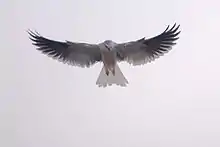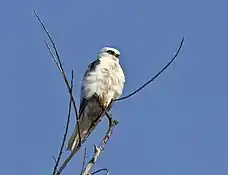White-tailed kite
The white-tailed kite (Elanus leucurus) is a small raptor found in western North America and parts of South America.
| White-tailed kite | |
|---|---|
 | |
| White-tailed kite with prey. | |
| Scientific classification | |
| Kingdom: | Animalia |
| Phylum: | Chordata |
| Class: | Aves |
| Order: | Accipitriformes |
| Family: | Accipitridae |
| Genus: | Elanus |
| Species: | E. leucurus |
| Binomial name | |
| Elanus leucurus (Vieillot, 1818) | |
| Subspecies[2] | |
| |
 | |
| Synonyms | |
|
Elanus caeruleus leucurus | |
Taxonomy
The white-tailed kite was described in 1818 by the French ornithologist Louis Jean Pierre Vieillot under the binomial name Milvus leucurus with the type locality as Paraguay.[3] It is now one of four species in the genus Elanus which was introduced in 1809 by the French zoologist Jules-César Savigny.[4] The word Elanus is from Ancient Greek elanos for a "kite". The specific epithet leucurus is from the Ancient Greek leukouros for "white-tailed": leukos is "white" and oura is "tail".[5]
For some recent decades, it was lumped with the black-winged kite of Europe and Africa as Elanus caeruleus and was collectively called black-shouldered kite.[6] More recently it was argued that the white-tailed kite differed from the Old World species in size, shape, plumage, and behavior, and that these differences were sufficient to warrant full species status.[7] This argument was accepted by the American Ornithologists' Union, so the white-tailed kite was returned to its original name. Meanwhile, the Old World E. caeruleus is once again called black-winged kite, while the name black-shouldered kite is now reserved for an Australian species, Elanus axillaris, which had also been lumped into E. caeruleus but is now regarded as separate again.
Description
The coloration of the white-tailed kite is gull-like, but its shape and flight is falcon-like, with a rounded tail. Mainly white underneath, it has black wingtips and shoulders. A mid-sized kite, it measures 35–43 cm (14–17 in) in length, spans 88–102 cm (35–40 in) across the wings and weighs 250–380 g (8.8–13.4 oz). Both the wings and tail are relatively elongated, and the tarsus measures around 3.6 cm (1.4 in).[8]


Distribution and habitat
The white-tailed kite was rendered almost extinct in California in the 1930s and 1940s due to shooting and egg-collecting, but they are now common again. Their distribution is patchy, however. They can be found in the Central Valley and southern coastal areas, open land around Goleta including the Ellwood Mesa Open Space, marshes in Humboldt County, and also around the San Francisco Bay. Elsewhere in California, they are still rare or absent. They are also found from southern Texas and eastern Mexico to the Baja California Peninsula and through Central and South America to central Argentina and Chile. Globally, they are not considered threatened species by the IUCN.[1] On rare occasions the bird can be found far outside its usual range. At different times, two had been sighted in New England as of 2010. [n 1]
Behaviour
White-tailed kites feed principally on rodents, and they are readily seen patrolling or hovering over lowland scrub or grassland. They rarely if ever eat other birds, and even in open cerrado, mixed-species feeding flocks will generally ignore them.[10] Outside the breeding season, they roost communally in groups of up to 100.
White-tailed kites have been observed in aerial combat at the margins of territories, locking talons in a behavior described as "grappling".[11]
Notes
- In August 2010, one was repeatedly seen at the mouth of the Housatonic River in Connecticut. "One of only two that we know of from New England", according to Frank Gallow, associate director of the Connecticut Audubon Society Coastal Center.[9]
References
- BirdLife International (2012). "Elanus leucurus". IUCN Red List of Threatened Species. 2012. Retrieved 26 November 2013.CS1 maint: ref=harv (link)
- Gill F, D Donsker & P Rasmussen (Eds). 2020. IOC World Bird List (v10.2). doi : 10.14344/IOC.ML.10.2.
- Vieillot, Louis Jean Pierre (1818). Nouveau dictionnaire d'histoire naturelle, appliquée aux arts, à l'agriculture, à l'économie rurale et domestique, à la médecine, etc (in French). Volume 20. Paris: Deterville. p. 563. The page is incorrectly numbered as 556.
- Savigny, Jules-César (1809). Jomard, Edme-François (ed.). Description de l'Égypte, ou recueil des observations et des recherches qui ont été faites en Égypte pendant l'expédition de l'armée française, publié par les ordres de sa Majesté l'Empereur Napoléon le Grand (in French). Volume 1. Paris: L'Imprimerie Impériale. pp. 69, 97–98.
- Jobling, James A. (2010). The Helm Dictionary of Scientific Bird Names. London: Christopher Helm. pp. 144, 225. ISBN 978-1-4081-2501-4.
- Parkes, K.C. (1958). "Specific relationships in the genus Elanus" (PDF). Condor. 60 (2): 139–140. doi:10.2307/1365270. JSTOR 1365270.
- Clark, W.S.; Banks, R.C. (1992). "The taxonomic status of the White-tailed Kite" (PDF). The Wilson Journal of Ornithology. 104 (4): 571–579.
- Ferguson-Lees, James; Christie, David A.; Franklin, Kim; Mead, David; Burton, Philip (2001). Raptors of the World. Houghton Mifflin. ISBN 0-618-12762-3.
- Sanders, Jack (19 August 2010). "Bird Notes: Hummingbird antics and some rare visitors". The Ridgefield Press. Ridgefield, Connecticut.
- Ragusa-Netto, J. (2000). "Raptors and "campo-cerrado" bird mixed flock led by Cypsnagra hirundinacea (Emberizidae: Thraupinae)". Revista Brasileira de Biologia. 60 (3): 461–467. doi:10.1590/S0034-71082000000300011. PMID 11188872.
- Whitt, Michael (1992). "Grappling in Black-shouldered Kites". Western Birds. Western Field Ornithologists. 23 (2): 81–83.
External links
| Wikimedia Commons has media related to Elanus leucurus. |
| Wikispecies has information related to Elanus leucurus. |
- White-tailed Kite – Elanus Leucurus – USGS Patuxent Bird Identification InfoCenter
- White-tailed Kite Species Account – Cornell Lab of Ornithology
- White-tailed Kite Stamps at bird-stamps.org
- "White-tailed Kite media". Internet Bird Collection.
- White-tailed kite photo gallery at VIREO (Drexel University)
- BirdLife species factsheet for Elanus leucurus
- White-tailed Kite species account at Neotropical Birds (Cornell Lab of Ornithology)
- Interactive range map of Elanus leucurus at IUCN Red List maps
- Audio recordings of White-tailed Kite on Xeno-canto.
